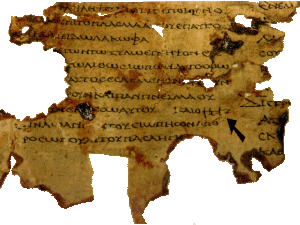
The kaige revision, or simply kaige, is the group of revisions to the Septuagint made in order to more closely align its translation with the proto-Masoretic Hebrew.[1] The name kaige derives from the revision's pervasive use of Koinē Greek: και γε [kai ge] ("and indeed") to translate the Hebrew: וְגַם [wə gam] ("and also"). The importance of this revision lies in its status as a precursor to later revisions by 'the Three' (i.e., Aquila, Symmachus and Theodotion) as well as the light it sheds on the origins of the Septuagint.[2]
The individual revisions characteristic of kaige were first observed by Dominique Barthélemy in the Greek Minor Prophets Scroll from Nahal Hever.[3] According to Arie Van Der Kooij "his thesis about the K[aige] T[ranslation] has been widely accepted, but his dating of Theodotion before Aquila has not."[4]
- ^ Dines, Jennifer Mary (2004). The Septuagint: Understanding the Bible and Its World. London: A&C Black. p. 81-82. ISBN 9780567084644.
- ^ Law, Timothy Michael (2013). When God Spoke Greek: The Septuagint and the Making of the Christian Bible. Oxford: Oxford University Press. p. 76. ISBN 9780199344338.
- ^ Tov, Emanuel (2011). Textual Criticism of the Hebrew Bible. Minneapolis: Fortress Press. p. 143. ISBN 9781451403299.
- ^ Van Der Kooij, A. (1983). "On the Place of Origin of the Old Greek of Psalms". Vetus Testamentum. 33 (1): 67–7. doi:10.2307/1517994. hdl:1887/10615. JSTOR 1517994.